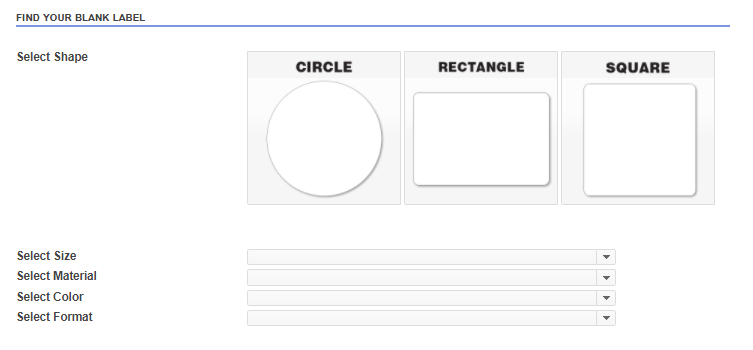How Space Labels Can Streamline Your Company and Personalized Classifying Tasks
In today's busy atmosphere, reliable organization is critical, and empty tags use a versatile option that can streamline your custom-made labeling projects. The benefits expand beyond simple ease; understanding the different means blank tags can change your processes is vital for optimizing their potential.
Benefits of Making Use Of Space Labels
Making use of empty tags provides many benefits for organization and efficiency in different setups. One significant benefit is the capacity to customize labels according to particular requirements, which boosts quality and availability. This modification is particularly valuable in atmospheres such as offices, stockrooms, and homes, where specific identification of items is important for smooth procedures.
Additionally, empty labels can substantially minimize time invested on labeling jobs (Blank Labels). Rather than relying upon pre-printed labels that may not precisely mirror existing stock or project requirements, customers can rapidly make and publish labels as required. This versatility decreases waste and promotes a much more lasting strategy to labeling
In addition, making use of empty labels can enhance overall organization by permitting customers to classify and prioritize items effectively. This systematization help in fast retrieval and inventory monitoring, cultivating a setting favorable to productivity. Finally, the cost-effectiveness of empty tags can not be ignored; they offer a budget-friendly solution for organizations and people alike, guaranteeing that labeling demands are satisfied without incurring unneeded costs. In recap, the benefits of making use of blank tags prolong past simple convenience, supplying considerable improvements in performance and organization.

Sorts Of Space Labels Available
When discovering the numerous sorts of empty labels offered, it's crucial to take into consideration the varied products and styles that accommodate different applications. Blank tags can be categorized into numerous vital types, each developed for specific usages and atmospheres.
Paper labels are extensively made use of because of their affordability and versatility. They are ideal for interior applications, such as filing systems, item labeling, and organization jobs. For outdoor or high-moisture settings, vinyl labels supply durability and resistance to water, making them excellent for classifying containers, outside equipment, and signs.
One more popular alternative is thermal transfer tags, which work with thermal printers. These tags are suitable for shipping and supply monitoring, as they give top notch prints that stand up to deterioration. Additionally, specialized tags, such as those with detachable sticky or static cling, offer distinct purposes, permitting momentary labeling without leaving residue.
Last but not least, tag sheets and rolls come in numerous shapes and sizes, accommodating various printers and applications. Understanding these sorts of empty labels allows customers to select the most reliable solutions for their business requirements, boosting efficiency and quality in labeling tasks.
Modification Options for Labels
Label personalization offers individuals the possibility to tailor their labeling options to fulfill particular requirements and preferences. This versatility is essential for improving organization and making certain that each label serves its desired objective efficiently.
One of the primary customization choices is the dimension and form of the tags. Users can choose from a range of measurements to fit different containers, folders, or surface areas. Furthermore, the material of the label-- such as paper, vinyl, or polyester-- can be picked based upon sturdiness requirements and environmental problems.
Color is one more important element of personalization. Users can select specific shades to match branding or to produce an aesthetic coding system that helps in quick recognition. Text and graphic alternatives enable for customized messages, logo designs, or signs, guaranteeing that tags communicate the required details plainly and beautifully.
Practical Applications for Everyday Usage

In the office, empty tags offer a myriad of features. They can be related to submit folders, making sure records are conveniently retrievable. In addition, classifying tools and devices assists preserve an organized work area, helping with performance and performance. Space tags can likewise be utilized for inventory management, permitting organizations to track supply levels and enhance buying processes.
Educational settings benefit greatly from blank labels too. Educators can use them to classify class materials, developing an orderly setting favorable to learning. Pupils can identify individual products to stop mix-ups, advertising obligation and liability
Additionally, during occasions or gatherings, empty labels can help in organizing name tags, food products, and supplies, making certain a seamless experience for participants. Generally, the versatility of empty tags makes them a vital tool for boosting organization across numerous daily applications.
Tips for Effective Classifying Jobs
Efficient labeling tasks need mindful preparation and focus to detail to maximize their business benefits. about his Recognize what items require labeling and the particular details each tag should share.
Following, pick the suitable tag type and product based on the atmosphere and period of use. For instance, water-proof labels are ideal for exterior applications, while removable tags work well for momentary company.
Layout your tags with clarity in mind. Blank Labels. Usage understandable fonts, contrasting colors, and easy graphics to boost readability. Uniformity in tag dimension and format also contributes to a cohesive look and feel
During the application stage, ensure surfaces are tidy and completely dry to advertise bond. Organize tags logically, grouping similar products with each other to increase effectiveness.
Finally, evaluate the efficiency of official source your labeling system periodically. Solicit comments from customers and make modifications as necessary. By using these methods, you can produce a labeling system that not only improves company yet additionally improves overall productivity and ease of access.
Final Thought
